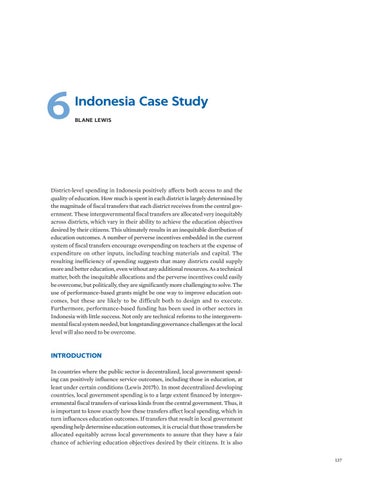6
Indonesia Case Study BL ANE LEWIS
District-level spending in Indonesia positively affects both access to and the quality of education. How much is spent in each district is largely determined by the magnitude of fiscal transfers that each district receives from the central government. These intergovernmental fiscal transfers are allocated very inequitably across districts, which vary in their ability to achieve the education objectives desired by their citizens. This ultimately results in an inequitable distribution of education outcomes. A number of perverse incentives embedded in the current system of fiscal transfers encourage overspending on teachers at the expense of expenditure on other inputs, including teaching materials and capital. The resulting inefficiency of spending suggests that many districts could supply more and better education, even without any additional resources. As a technical matter, both the inequitable allocations and the perverse incentives could easily be overcome, but politically, they are significantly more challenging to solve. The use of performance-based grants might be one way to improve education outcomes, but these are likely to be difficult both to design and to execute. Furthermore, performance-based funding has been used in other sectors in Indonesia with little success. Not only are technical reforms to the intergovernmental fiscal system needed, but longstanding governance challenges at the local level will also need to be overcome.
INTRODUCTION In countries where the public sector is decentralized, local government spending can positively influence service outcomes, including those in education, at least under certain conditions (Lewis 2017b). In most decentralized developing countries, local government spending is to a large extent financed by intergovernmental fiscal transfers of various kinds from the central government. Thus, it is important to know exactly how these transfers affect local spending, which in turn influences education outcomes. If transfers that result in local government spending help determine education outcomes, it is crucial that those transfers be allocated equitably across local governments to assure that they have a fair chance of achieving education objectives desired by their citizens. It is also 137






